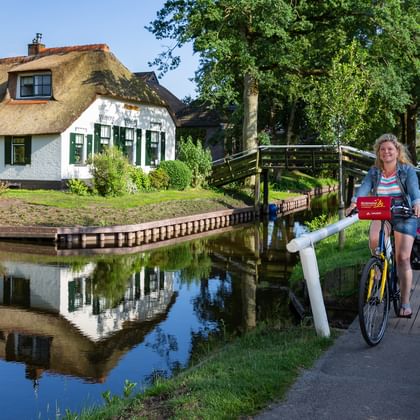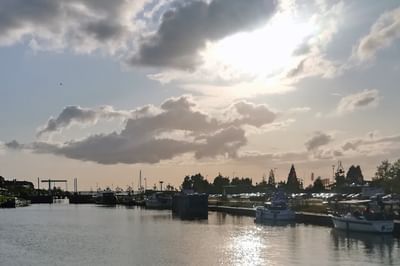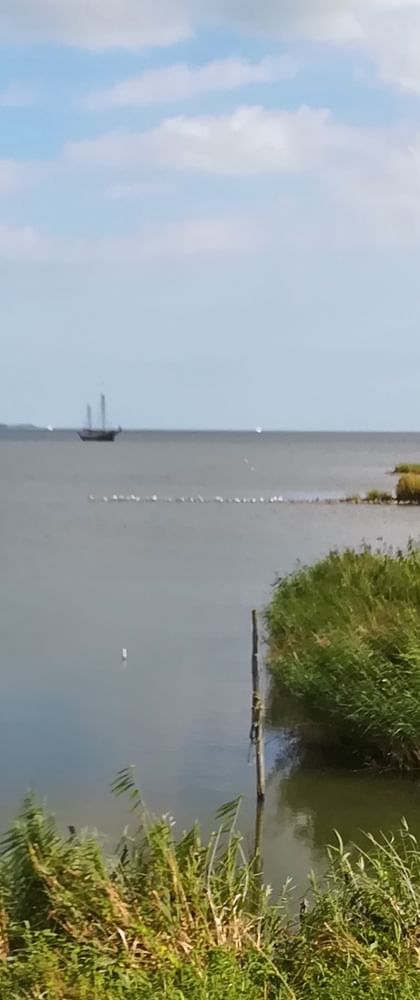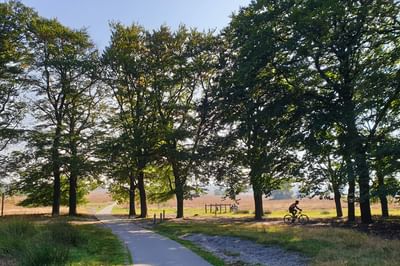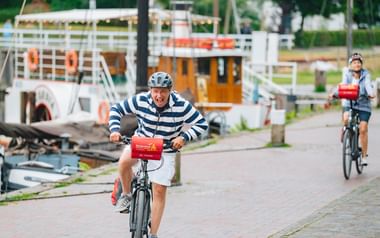Popular region for cyclists - the lake IJssel
The Ijsselmeer is one of the most beautiful destinations and is ideal for cycling. You can cycle the day tours perfectly with the very simple junction system. The long-distance cycle routes (LF routes) are marked in both directions with rectangular white signs with green lettering.
In the vicinity and further surroundings of the Ijsselmeer there are numerous rivers, mostly small and medium-sized, that feed it with water. The best known and largest is the IJssel, which branches off from the mighty Rhine in the Netherlands and has an average width of about 70 meters. After about 20 km of river, the IJssel “swallows” the first major tributary, the Issel. All other major tributaries flow into the IJssel from the right. To the left, the river is accompanied by the picturesque moraine hills covered with forest slopes up to 90 meters high.
Enchanting small towns around the lake IJssel The IJssel then flows into a bay of the IJsselmeer near Kampen. Around the IJsselmeer there are numerous small towns with sights.
Harderwijk
Take a walk through the historic city from the 13th century. With its cozy terraces, beautiful squares and many shops on Lake Veluwesee. Discover
- Dolphinarium “Dolfinarium Harderwijk”
- The coast (yacht harbour and beach)
- The hinterland Veluwe with its forests and heathlands
- The city centre with the late Gothic Liebfrauenkirche from the 15th century. the picturesque town gate of Vischpoort
Discover the beautiful beach at "“t Mirnser Klif” on the way to Lemmer

Lemmer
Take a discovery tour of Lemmer. The town is one of Friesland's largest water sports resorts. It is one of the most important fishing towns in the Netherlands and attracts many tourists, especially in fine weather, with its beautiful beach right next to the harbour.
Worth seeing:
- The harbour with an extremely narrow entrance
- The movable bridge over the harbour entrance
- The lock "Lemstersluis"
- The Woudagemaal - the only still functioning steam bailer in the world. It is on the list of UNESCO as a world heritage site.

Amsterdam
Visit the world-famous capital of Holland from the 17th century. Century. Enjoy the historical buildings, the beautiful museums and the cosy atmosphere. Take a tour of the canals, stroll through the Vondelpark and shop in the old city centre. Amsterdam is really unique!

Top-Sights
- Anne Frank House, known for her diary entries during World War II
- Van Gogh Museum - he is considered the founder of modern painting
- Rijksmuseum - the Imperial Museum houses exhibitions of art, craft and history. Among other things, you will find paintings from the Golden Age of the Netherlands, the 17th century. Century, when the Netherlands experienced an economic and cultural bloom
- Heineken Experience - everyone knows the Dutch brewery with the delicious beer
- Vondelpark - an approximately 47-hectare park in Amsterdam's Oud-Zuid district
- Red light district - prostitutes loll in shop windows and one neon sign is flashier than the next. Meanwhile this quarter has become a tourist attraction and attracts numerous visitors
- Jordaan district - one of the most popular districts in Amsterdam with numerous canals, cute shops and cosy cafes
- Canal trip - a must to get to know the city from the water. Numerous boat tours in the most different price ranges are offered here. If you book a hop-on-hop-off boat tour, you can stop at the main sights and then take the boat again.
- Hermitage Amsterdam - an offshoot of the Hermitage in Saint Petersburg. Here there are changing exhibitions on historical and art-historical topics
- Royal Palace - the "Paleis op de Dam" is located directly in the city centre of Amsterdam and around it stretches the historical city centre of the city.
Amsterdam also has many beautiful beaches! Beach Zuid, Dok and Sloterplas are close to Amsterdam and all have beach restaurants, water and sand. After Hamburg and Vienna, Amsterdam is the city with the most bridges in Europe. Around 1,300 bridges lead over the world-famous canals.
Naarden
This beautiful town in the green Gooi region is one of the best preserved fortified towns in Europe. As the fortress of Naarden was part of the Dutch waterline, no houses were allowed to be built outside the fortress walls. This was the only way to keep the field of fire (and thus the view of the enemy) clear. Thus the area around Naarden-Vesting remained free until the military fortress was dissolved in 1926. Only then was the town able to expand, unlike the surrounding municipalities such as Bussum and Huizen. Naarden-Vesting was granted city rights in 1351 and was the only city in the Gooi region. Due to its strategic location, Naarden became a centre of the 16th century. In the 18th century it was a military fortress and part of the defence line "De Hollandse Waterlinie".In the 17th century, the town acquired its typical star shape with double outer walls, access gates and bastions, which has been magnificently preserved to this day.
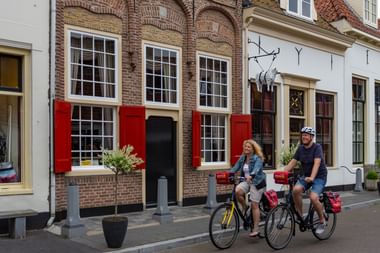
Huizen
In the centre of Huizen you will find a medieval church, many farms and characteristic houses from earlier times. Architecturally remarkable is the residential complex de Sfinxes (Sfinxwoningen) from 2003. The buildings are mostly built into the lake in a sphinx-like structure.
Muiden
The Muiderslot is a true work of art. Romantically dreamy, the water castle is located on the small island and can only be reached via a bridge. Most of the castle dates back to the Middle Ages.
The town of Muiden is a water sports center with restaurants and cafes. The old houses tell their story from times gone by. Along the Herengracht there is a busy boating industry. Sit down in one of the cozy cafes by the lock and enjoy the beautiful view! A boat trip to the fortified island of Pampus starts from Muiderslot. The island is 205 meters long and 164 meters wide and has 2 inhabitants. Pampus used to be a notorious sandbank and many ships are stranded here. A Dutch expression “before the pampus”, i. e. unable to continue driving, still means being almost unconscious due to exhaustion.
Volendam
In Volendam, the most famous fishing village in Holland, there is something to see all year round. Visit the cosy harbour with old Dutch ships or have your picture taken in traditional Volendam costume. Nowadays Volendam is a town with about 22,000 inhabitants. The population differs from the rest of the Netherlands in its customs, clothing and dialect. In the Volendam Museum you can learn all about the history of the famous fishing village.

Hoorn
The heyday of Hoorn was in the 17th century. It was one of the most important centres of the Dutch East India Company. Like Amsterdam and Enkhuizen, Hoorn developed into a very prosperous city. Even today, dozens of monuments and churches bear witness to this time steeped in history. By the way, Hoorn gave its name to the southernmost point of the American continent, Cape Horn. Even today, the maritime past shapes the face of the port city. Enjoy a stroll through the historic city centre with an afternoon of shopping and a delicious meal.

Enkhuizen
The pretty harbour town is surrounded by water on three sides. The town owes its wealth to herring fishing and trade. Already in the Bronze Age there was a settlement here in the 14th, the first harbour was dug - the well-preserved Zuiderhavendijk from this period can still be seen today. In the 15th and 16th centuries, the harbours were expanded and a city fortification was built. As a reward for its loyalty to Prince Willem van Oranje, the town was granted the right to levy a tax on all ships on the Zuiderzee in 1573. In the 17th century, the town had the largest herring fleet in the Netherlands and trade with the Baltic countries, England, West Africa and India made Enkhuizen rich.
Places of interest in Enkhuizen
- The Zuiderzee Museum - where you can get a good impression of the history of Enkhuizen and the former Zuiderzee.
- Drommedaris fortified gate (1540) - it served as a fortified gate for a long time and protected the entrance to the harbour.
- The town hall in the Dutch Stadhuis in classicist style
- The idyllic old town with historic buildings
- Enkhuizer Waag - in this Renaissance building goods used to be weighed
Stavoren
The town used to be a rich trade centre and had the town charter. She was a member of the Hanseatic League. The import of wheat was one of the most important sources of income at that time. Due to floods, wars and the silting up of the harbour, Stavoren fell into poverty and lost its important trading role at the end of the Middle Ages. Nowadays the main income is generated by water sports. Especially in summer, because Stavoren lies on one of the main routes from the IJsselmeer to the Frisian lakes. Fishing and trade are deeply rooted in the identity of the city of Stavoren. One of the sights of the town is the Fish Fountain, created by US artist Mark Dion from a pen and ink drawing from 1556, when Stavoren was a thriving seaport. " The big fish eat the little ones": a huge fish head emerges from the tank and its open mouth "devours" curious visitors.

Kampen
Water sports, history and nature - that's what Kampen is known for. In Kampen on the IJssel, the town's Hanseatic past can still be seen everywhere: 500 monuments, St. Nicolas Church, the Gothic House, the town gates and a replica of the medieval merchant ship "De Kamper Hanze Kogge". With all these impressive monuments, the best way to discover the historic city centre is on a city walk. For example, from the Korenmarktpoort in the direction of the Oude Vispoort on the IJsselkade - only a stone's throw away - to the old Raadhuis, , where the fish market has been held since the 14th century. Century the fish market is held. During a walk through the city centre magnificent patrician houses and numerous monuments recall the time of the Hanseatic League. The small settlement on the river IJssel quickly became a thriving trading town in the Middle Ages – and in the 15th century one oft he most powerful cities in the Hanseatic League. Skippers from Kampen sailed to the Baltic Sea, the German North Sea and travelled between England, France and Holland. This development was particularly driven forward by a new type of ship: the Kogge. As a reminder, a cog was built in Kampen using the original materials of that time. On certain occasions the ship even goes to sea. In the early 19th century Kampen became a centre of the tobacco industry. " Kampen Holland” appears on the beautiful cedar box with cigars of the cigar factory De Olifant. The basis for the success of De Olifant has been the use of pure natural raw materials of the highest quality for many years.
Also worth seeing is the Stedelijk Museum. It is located in the former town hall. There you can learn more about the history of Kampen. It is equipped with beautiful museum pieces and with audiovisual means a picture of the past, the present and the future can be seen.

Elburg
Time seems to have stood still in the Hanseatic city of Elburg. Narrow streets and monumental buildings bring history to life. Anyone who strolls through the fortress city will feel transported directly to the Middle Ages. The old town fortifications with magnificent trees, the narrow streets, the “Keitjesstoepen” – mosaic-like fields in front of the houses – transform the fortress town into a picturesque ensemble. The location of Elburg is also a consequence of a strategic decision of the former Duchy of Geldern. Most of the trade took place over water and the old wooden ships still in the harbour, the so-called Botters, keep alive the memory of Elburg’s past
Nationalpark Weerribben-Wieden
Covering a good 10,000 hectares, this national park is the largest continuous lowland moor in north-western Europe. A labyrinth of ponds, lakes, ditches, mysterious swamp forests, extensive reedbeds and hay meadows full of flowers - this protected area is home to many rare plants and animals. Aquatic and marsh plants such as crayfish claw, water lily, round sundew, pechnelweed and narrow-leaved cottongrass. Species such as the large fire butterfly, the crested damselfly - of some species almost the entire Dutch population lives in this park. Thanks to the excellent water quality, Weerribben-Wieden has been home to the otter since 2002.
In Blokzijl you walk past historical buildings, centuries-old churches and castles, in Giethoorn countless thatched farms were built on small peat islands and connected by over 170 wooden bridges. The name “Giethoorn” comes from the horns of wild goats, which the first inhabitants of the region found in the moor. They called this place Geytenhoren and it became Geythorn and later Giethoorn.
